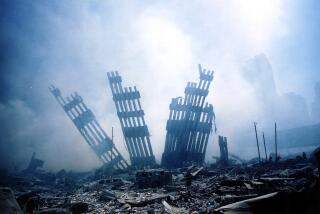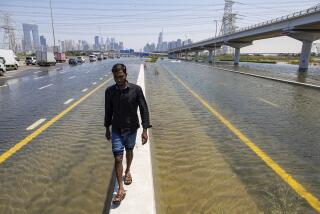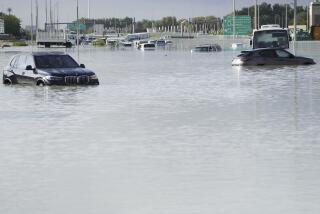Nations Rally to Curb Oil Spill : Iraqi Warplanes Land in Iran; 5 Scuds Intercepted : Gulf War: Bush orders U.S. experts to the region to help the Saudis protect vital facilities. The incident could produce history’s worst oil disaster.
DHAHRAN, Saudi Arabia — An international containment effort was under way Saturday to hold back a massive surge of crude oil unleashed from Kuwaiti oil facilities into the Persian Gulf in what officials say may be the worst oil disaster in history.
The 30-mile-long, eight-mile-wide oil slick, already more than 20 times larger than the Exxon Valdez oil spill in Alaska and spreading at an alarming rate, potentially threatens petrochemical and water desalination plants throughout the region and could upset the ecological balance of the entire Persian Gulf, authorities said.
Saudi officials said they are racing to protect key facilities with booms. In Washington, President Bush ordered a team of oil pollution and environmental experts, led by the U.S. Coast Guard, to fly to Saudi Arabia immediately “to assist the Saudis in their efforts to contain the oil slick,” said Sean Walsh, an assistant White House press secretary.
Allied officials are also studying the possibility of igniting the slick, or portions of it, to minimize its impact.
By Saturday evening, as much as 6 million barrels of crude oil had been pumped into the gulf. U.S. officials said they believe Iraq deliberately unleashed the oil from five huge oil tankers moored off the Kuwaiti coast, loaded with an estimated 3 million barrels of crude, and opened the taps on a major pipeline connecting Kuwait’s Sea Island loading terminal 10 miles offshore with the Al Ahmadi loading facility.
Possibly 3 million barrels could be dumped from storage at Al Ahmadi, U.S. officials in Washington said.
Analysts said the slick could turn into the world’s worst, exceeding Mexico’s nine-month offshore well spill, capped in March, 1980, after spewing between 3.3 million and 10.2 million barrels.
Fires raged at one loading facility, Saudi officials here said. In addition, part of the slick near the Sea Island terminal was on fire Saturday night, but that fire appeared to be diminishing, U.S. officials said. They said the cause of the blaze was unknown.
Iraq claimed that heavy U.S. bombing had sprung leaks in the loaded oil tankers. But Pentagon spokesman Pete Williams said Saturday that “Iraq is intentionally creating the worst environmental disaster in the Persian Gulf region. It is conducting an indiscriminate environmental war on its neighbors.”
Marine Maj. Gen. Martin L. Brandtner, briefing reporters at the Pentagon on Saturday, said that while the spill would not affect military operations, “we do not intend to sail through it.”
He noted that aerial bombardment to break up or ignite the spill is a possibility, adding, “I am confident we have the technology, the expertise and the equipment to solve this problem in the best manner that we can.”
Military officials would not comment publicly about whether U.S. forces would try to shut off the flow of oil at the source. But one senior officer said privately that it is possible that the storage facilities at Al Ahmadi would be bombed or shelled to burn up as much oil as possible and prevent it from being spilled into the gulf.
An airborne or amphibious operation to put troops ashore to seize Al Ahmadi was dismissed by officials as unlikely because the facility is well defended by Iraqi forces and the military is unwilling to risk as many troops as would be necessary to secure it.
The bodies of oil-soaked sea birds littered the blackened beach at the Saudi border city of Khafji, 75 miles south of the Kuwaiti capital, and others floated shivering in the oily surf. Dolphins surfaced for air just outside the breaker line before the slick moved back offshore Saturday afternoon.
“I think by any standard what we’re seeing here is something the whole world has never seen before in terms of an oil slick,” said Abdullah Dabbagh, director of the Research Institute at King Fahd University of Petroleum and Minerals, the high-tech monitoring facility in Dhahran that for years has tracked oil spills in the gulf.
Dabbagh and other experts said it will take at least three days for the slick to reach Jubayl, a giant petrochemical center, where a pair of water desalination plants generate about half of Saudi Arabia’s fresh water supply.
Saudi officials sought to downplay the threat to industrial facilities along the eastern coast of Saudi Arabia. They predicted that large floating booms being hurriedly installed would protect key facilities from ingesting crude-fouled seawater as the slick moves south. Similar protective measures were under way in Bahrain, Qatar and the United Arab Emirates, which also have large water desalination plants that supply the bulk of their household and agricultural water.
“Saddam’s oil spill is the largest ever in history, but we believe there is no military significance to it at all, and as well no economic significance,” said a spokesman for Saudi Arabia’s Ministry of Petroleum.
“We are very confident it will not impact any of our industry--oil or petrochemical, water or electrical--because these booms, they are really very effective.”
Khaled Fakhoury, head of Bahrain’s Environmental Protection Committee, said he believes that essential facilities in Saudi Arabia and Bahrain would be protected from being clogged by elaborate flotation devices and filtering methods adopted after the 1983 oil-well spill at Nowruz, in Iran, which dumped an estimated 1.9 million barrels into the gulf, forcing the Saudis to close down their desalination plants for two weeks.
Bahrain’s main desalination plant, for example, was constructed in a protected bay where the water entering the intakes can be easily protected from floating oil. In addition to booms, the desalination plant has skimmers and other filters that can remove oil that sinks below the surface.
Nearly all of the water used by households and in agriculture in the desert economies of the gulf is made from seawater. Desalination plants remove salt from the water by reverse osmosis, a process similar to passing water through a giant sieve. Most residents of the area rely on bottled water from natural springs for drinking.
“I don’t think we face a catastrophic situation, because both Saudi Arabia and Bahrain have quantities of water in wells which can be used for drinking,” Fakhoury said.
But Dabbagh was much more cautious in his assessment of how far booms could protect against the surging oil. “With volumes like the volumes we’re seeing now, I don’t know whether these booms are going to be effective or not,” he said. “We’ll leave it to time to be able to see. It’s going to be a very difficult time to try and fight this.”
Even the most optimistic Saudi officials admitted that the spill is likely to have dire consequences for marine life in the gulf, and private salvage officials predicted it will be difficult to keep the rapidly expanding oil slick from moving near critical industrial facilities.
Using complicated computer models that have charted wind, temperature and current patterns in the gulf over a period of years, scientists at the King Fahd research institute are working to predict the movement of the oil slick--whether it would remain offshore long enough to bypass Saudi Arabia’s most critical industrial facilities.
Prevailing currents in the gulf sweep counterclockwise down past Saudi Arabia to Qatar, then up again toward Iran, said Abdul-Rahman Awadi, a Kuwaiti Cabinet minister who heads the Regional Organization for the Protection of Maritime Environment.
Awadi and other officials said it appeared the oil has been seeping southward for at least two or three days, nudging past the Saudi border at Khafji on Friday. While it left an oily film on the beach at the abandoned border city, high tides and stiff winds had moved it back offshore by Saturday afternoon.
Much will depend on how far onshore and how rapidly south the slick moves in the coming days, Dabbagh said. “If we have northerly winds, which is dominant this time of year, then quite a bit of that oil’s going to come south and will impact other shores in Saudi Arabia,” he said.
Only a small portion of the slick appears to have reached Khafji so far, he said, and the bulk of the slick is not expected to reach Jubayl for three to four days.
The two desalination plants at Jubayl supply about 60% of Saudi Arabia’s water and nearly 90% of the water used in the capital at Riyadh. However, officials there said the city would likely weather the crisis.
There are still about 100 deep wells surrounding the city, as well as a waste-water recovery plant, which could feed into a series of five distillation plants that have not been used since the desalination plants at Jubayl went on-line. In this manner, about half of Riyadh’s water supply could be restored, a Saudi official said.
A senior government official in Washington, speaking on condition of anonymity, said an Energy Department study on how to cope with a massive oil spill in the gulf determined that the only way to fight such an ecological disaster is to attempt to burn the oil.
“It makes sense to torch it as soon as possible. It’s the quickest and best response,” he said. “
The study, prepared about a month ago by the Sandia National Laboratory, was distributed to the Joint Chiefs of Staff and the National Security Council, the source said. He said Energy Secretary James D. Watkins had ordered the report in anticipation of the threat that an oil spill posed.
The source said that some Energy Department figures have for several days been urging the Pentagon to act on the report’s recommendations.
“It’s a function of time as much as anything else,” he said. “If you don’t get it quickly, it films out and is less volatile.”
Indeed, experts said Friday, when the existence of the slick became known, that only certain grades of crude oil in fairly thick quantities would burn, and that over a period of time, as the amount of oil floating on the water grew thinner, it would be less likely to burn.
Environmental officials were stunned by pictures of the oil washing ashore at Khafji, which showed cormorants, sea birds now nesting along the Persian Gulf coast, drenched in oil.
Murphy reported from Dhahran, Saudi Arabia, and Wallace from Manama, Bahrain. Times staff writers J. Michael Kennedy in Riyadh and John M. Broder and James Gerstenzang in Washington contributed to this story.
More to Read
Sign up for Essential California
The most important California stories and recommendations in your inbox every morning.
You may occasionally receive promotional content from the Los Angeles Times.









